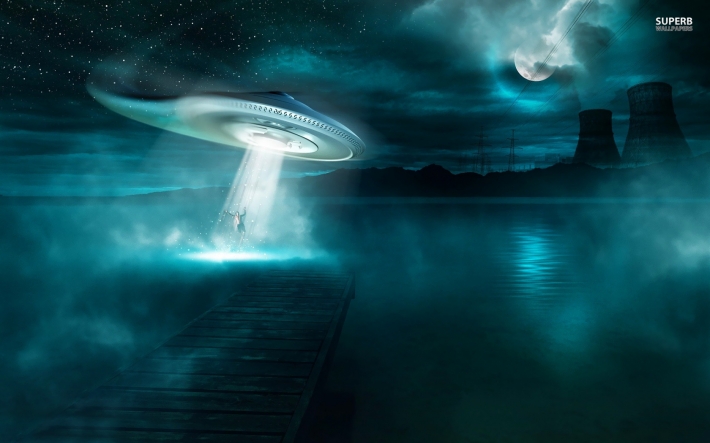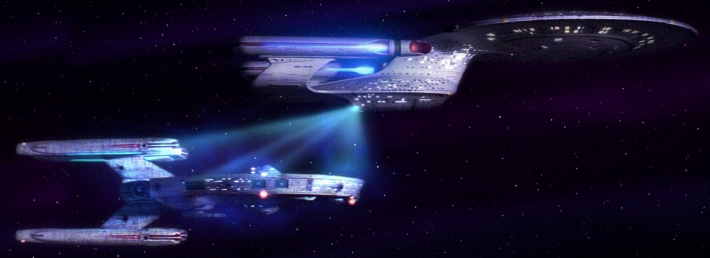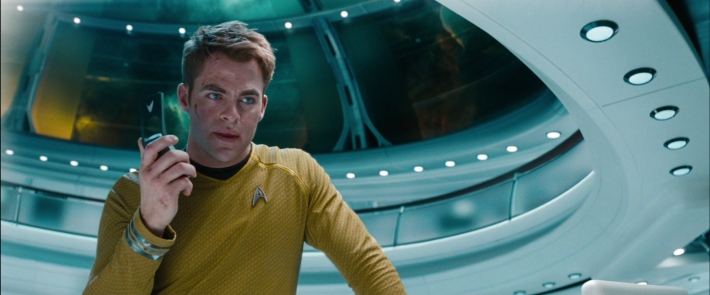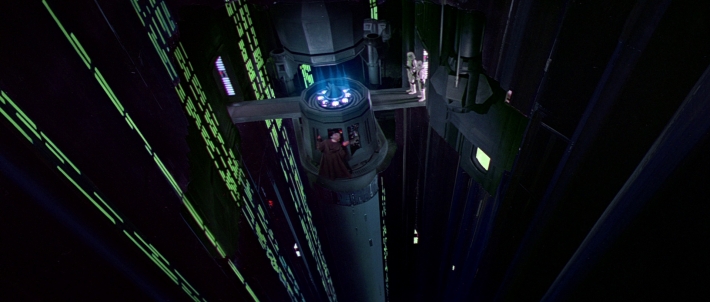Tractor beams have been a common feature of science fiction literature and films for most of the last century. Popularised by images of the Starship Enterprise grasping an enemy ship with beams of light, or the Millenium Falcon been drawn slowly into the body of the Death Star, they seem to be a multi-functional feature of most space ships and space stations, though their mechanism is at heart highly counter-intuitive and a matter of mystery to SF fans. It usually appears as a piece of applied phlebotinum, a piece of future technology that is simply beyond our comprehension.
Despite being a powerful visual device, best remembered for appearing in numerous SF films and television shows, the first uses of tractor beams in fiction occurred in SF stories and novels early in the 20th century, during the rise of pulp SF and publications such as 'Amazing Stories'. The earliest use of the term 'tractor beam' was by 'Doc' Smith in his novel, 'Space Hounds of IPC', serialised in 'Amazing Stories' in 1931, to refer to the device by which his protagonists pick up the pieces of a destroyed space ship:
Brandon swung mighty tractor beams upon the severed halves of the Jovian vessel, then extended a couple of smaller rays to meet the two little figures racing across the smooth green meadow toward the Sirius.
Three years previously, Edmond Hamilton had referred to an 'attractive' ray in 'Crashing Suns', similar to our conception of a tractor beam today, though he did not coin a phrase to describe it:
A spark of intense white light had suddenly broken into being on the platform beneath us, a beam of blinding light that stabbed straight up toward us, bathing the cruiser in its unearthly glow. And suddenly our ship was falling!
Sarto Sen sprang to the controls wrenched around the power-lever. "That ray!" he cried. "It's attractive! - it's pulling us down!" Our ship was vibrating now to the full force of its generators, but still we were falling...
In these early novels, the purpose of tractor beams seems to be mainly in moving ships or the debris of ships, perhaps as a way of cleaning up a scene of battle. In 'Crashing Suns', the technology is used as a way of seizing control of another ship without its consent, as it is clearly a surprise and quite alarming to the crew. The device has since been used to secure and drag cargo, retrieve passengers, and as in 'Crashing Suns', to hold other ships like 'grappling hooks' on sea-going ships. Tractor beams have also been cited as a very effective method of alien abduction...

Credit: Superb Wallpapers
It seems Hamilton may have missed out by not coining a phrase by which to refer to his beams, as Smith's novel is more commonly cited as the earliest instance of tractor beams in literature. At around same time as Hamilton introduced his rays with attractive properties, Philip Francis Nowlan included something called 'repellor beams' in the first Buck Rogers novel, 'Armageddon 2419'. Enemy ships used these beams for support and propulsion. It appears that Nowlan's use of the term 'repellor beam' may have given Smith the inspiration to give a name to Hamilton's 'attractor beam', shortening the term to 'tractor beam'.
Recent discoveries may have fuelled writers' interest in light beams with weird and wonderful properties: Wilhelm Röntgen had discovered X-rays in 1895; alpha, beta and gamma rays were isolated just a few years later; radio had been gaining in popularity for the past couple of decades, but became a commercial success in the 1920s. Only a couple of decades previously, Russian physicist Pyotr Lebedev proved experimentally that light has a property of momentum and so exerts a force on surfaces it is exposed to. This is known as radiation pressure, or a scattering force. It is not surprising that the SF writers of the early 20th century began to propose technology operating on the possibility that this ability of light could be reversed, so photons could be made to attract objects rather than repel them.
A number of methods have been proposed and realised experimentally that have properties similar to the tractor beams of fiction. However, their applications are often very different from that in most science fictions films and novels. As a result of radiation pressure, repellor beams are more easily realised than tractor beams. An example of a method that relies on this radiation pressure to create a 'pushing force' is known as 'optical tweezers'.

Credit: CBS Television Distribution
An effect of 'optical tweezers' makes it possible to trap particles in the focus of one or two laser beams. Absorption, reflection or refraction of light by the particle generates a force, which can be used to manipulate the particle. Particles trapped in the beam follow the intensity gradient of the light, so they move until they reach an equilibrium where the intensity is at a maximum. However, this can only work on a microscopic level so far, as only several milliwatts of power are generated, resulting in only a few piconewtons of force. This force is significant on a microscopic level, as just 10 piconewtons are enough to pull a bacterium through water ten times faster than it would be able to swim. 'Optical tweezers' have been used in cell biology for non-invasive manipulation and mechanical measurement of microscopic objects. However, this requires an atmosphere in order to work, and the forces involved would not be great enough to move ships, cargo and debris, unlike the tractor beams of science fiction.
The 'optical tweezers' method uses the 'gradient force' to create an effect similar to that of a tractor beam, but it has its limitations. It is counter-intuitive to use a beam of light to physically pull a particle towards a source via a backward scattering force, otherwise known as an Optical Pulling Force (OPF), yet recent research seems to have succeeded in achieving just that.
In 2011, Chinese scientists proposed a method by which a backward pulling force could be generated from a forward-propagating Bessel beam. Photons in the Bessel beam excite several multipoles in the particle, scattering the beam. If the angle of scattering is just right, then the direction of propagation can be negative, so the particle is pulled towards the force. Bessel beams are lasers, but instead of a single point, they create a dot surrounded by concentric rings. They suffer less diffraction than a standard laser, so the central beam stays focused. The benefit of Bessel beams is that they cannot be blocked. The beam is formed by interference patterns from light travelling at an angle, so if broken, the central beam of the laser reforms after a distance. This 'self-healing' mechanism means that stray space debris could not disrupt the working of the tractor beam and enemy ships could not attempt to block the beam and prevent its operation.
Physicists at New York University have proposed a similar method for creating a tractor beam effect using Solenoid beams, which also suffer less diffraction than other lasers. The Solenoid beams form a spiral around a central beam. This method has been experimentally realised, unlike the Chinese scientists' Bessel beams. (I understand that was a lot of science in one go and it's about to continue, so to break the tedium, here's a picture of Chris Pine. Apologies to anyone who was expecting Bumblesnatch, but I feel like I've already indulged you quite a bit.)

Credit: Paramount Pictures
Most recently, research at the University of St Andrews and the Institute of Scientific Instruments (ISI) in the Czech Republic have also succeeded in reversing the radiation scattering of light. A special optical field was generated by directing a laser through a lens and onto a reflective surface. This caused the reflected photons to pass back across the beam and interact with it, resulting in a negative force upon the photons. The beam can be used to sort particles simply and inexpensively. Particles held in the beam rearrange themselves in a way that increases the strength of the beam, saving energy and increasing the efficacy of the process. The negative force is also very specific to the size and composition of the object that the beam is directed at, allowing for the optical sorting of particles. Furthermore, rotation of the polarisation of the laser beam can control the motion and sorting of particles. You can watch a video of the results at the University of St Andrews website. There is clear evidence of the particles being controlled and sorted by the beam in the second half of the video.
NASA has offered funding towards the study of Bessel beams and Solenoid beams as a means to create tractor beams. However, their intended usage doesn't anticipate galactic warfare. Such technology could be used instead to gather samples for analysis during future missions, either from orbiting spacecraft or rovers operating on the planet surface. This would require the generation of far greater forces than are currently achievable. The transfer of energy is of most concern here, because scaling up these operations would require a very powerful laser and a lot of energy.
It seems it might be a while before research can produce results that work on a macroscopic scale, as the energies required are not feasible at present. One further problem to overcome would be the result of Newton's law that states that forces must be equal and opposite. If a spaceship uses its tractor beam to pull upon another, it will experience an equal pulling force upon itself, and so will be drawn towards the spaceship it is trying to control. The ship operating the tractor beam would need to have a considerably greater mass than the ship it is trying to capture. Otherwise it would need thrusters to keep it in place while operating the tractor beam. This would increase energy consumption and cost. It seems that tractor beams would be very expensive to run in reality. Perhaps this would mean they are not economically viable, or that they should be kept as a last resort.

The Reactor Core of the Death Star
Credit: Lucasfilm
In the 'Star Wars' universe, tractor beams are used often to guide spacecraft into landing at spaceports and docking bays. These ports would often be on planets and large ships and so they would have a higher inertia than the vessel the tractor beam is guiding in. This would be feasible. Other craft that employ tractor beams include warships, such as Star Destroyers and the Death Star, all of which would have a great mass and should have little trouble in constraining smaller ships, as the Death Star is able to capture the Millenium Falcon with ease. The tractor beams upon the Death Star take their power from the main reactor, which seems appropriate given the vast amounts of energy it would require to operate.
The tractor beams in 'Star Trek' are described as attenuated linear graviton beams. A graviton is a hypothetical particle which transmits the force of gravity. These beams are described as being capable of attracting and repelling, they can either hold an object in position, change its position or trajectory. They are also often used to tow other ships. These tractor beams differ from those that have been considered as possible in our universe because they consist not of photons, but of gravitons, which have not been proven to exist in our universe. However, as the photons exert a force due to radiation pressure, the gravitons exert a force of gravity. This allows the beam to have attractive properties, in addition to repulsive.
Despite having its origins in the pulp science fiction of the early 20th century, tractor beams have found popularity through their dramatic visual depiction in film and television. The slow drag of our heroes' ship into the clutches of the enemy tractor beam certainly lends dramatic tension to a scene in real time, which can't quite be emulated in a novel. Some productions seem to have given thought to the plausibility of the technology and have restricted their use of tractor beams to reflect their realistic limitations. This sense of realism is important in a tale of science fiction where, potentially, anything is possible. However, based on real scientific research into the subject, the energies required to produce a tractor beam on a macroscopic scale would be huge. This seems to be the greatest liberty SF writers take with tractor beams in their work, though it's conceivable that technology will have advanced in their SF universes to accommodate devices with such a thirst for energy. It seems like it may be quite some time before we can create tractor beams with the dramatic purposes depicted in film and television, though their applications on a microscopic scale are currently of huge benefit to Biochemistry.
References & Further Reading
- 'Star Trek' Television Series, CBS Television Distribution (1966-2005).
- 'Star Wars' Film Series, Lucasfilm (1977-2005).
- Hamilton, 'Crashing Suns', Popular Fiction Publishing (1928).
- Nowlan, 'Armageddon 2419', Amazing Stories (1928).
- Smith, 'Space Hounds of IPC', Amazing Stories (1931).
- Chen et al, 'Backward Pulling Force From A Forward Propagating Beam', Nature Photonics (2011).
- Cizmar et al, 'Experimental Demonstration Of Optical Transport, Sorting And Self-arrangement Using A 'Tractor Beam', Nature Photonics (2013).
- Sukhov and Dogariu, 'On The Concept Of “Tractor Beams"', Optics Letters (2010).
Listing image: Lee Andrew / DeviantArt
